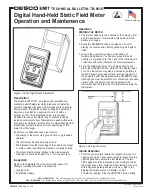
TB-6518
Page 3 of 4
DESCO EMIT WEST
- 3651 Walnut Avenue, Chino, CA 91710 • (909) 627-8178 • Fax (909) 627-7449
DESCO EMIT EAST
- 90 Hudson Road, Canton, MA 02021-1407 • (781) 821-8370 • Fax (781) 575-0172 • Web Site: DescoEMIT.com
recognized standard, we recommend the test procedure
published by the ESD Association as Standard 3.1. This
standard may be obtained from the ESD Association, 7902
Turin Road, Suite 4, Rome, NY 13440-2069, (315) 339-6937.
Maintenance
BATTERY REPLACEMENT
The unit should be off while replacing the battery. Normal
battery life is about 40 hours of use. Replace the battery
when the "BAT" indicator appears in the display above the
"HOLD" indicator position for more than an instant or
change at least once a year. Dead battery voltage is
approximately 7.2 volts.
Figure 5. Replacing batteries.
Replacement type is Eveready #216 or equivalent NEMA
1604. An alkaline type is recommended where longest
service life is important. Remove the battery when storing
the instrument for an extended period of time.
NOTE: After you change the battery you will need to re-
zero the meter.
CLEANING
If the 50551 is used in a dirty or dusty environment, it may
be necessary to clean the sensor to ensure proper
operation.
Foreign materials which may enter the aperture associated
with the input electrode can generate undesired signals,
offset or drift, thereby impairing the accuracy and utility of
the instrument. It is imperative that the area around the
aperture be kept scrupulously clean at all times. This can
best be done by proper care, handling and storage of the
instrument. Loose dust or other particulate matter may
simply be blown away with low pressure instrument grade
air.
More severe contamination may be removed by spraying or
flushing with the least practical amount of clean technical
grade isopropyl alcohol. Stand with instrument on end and
allow to dry thoroughly for several hours. Cleaning with any
solvent should
NOT
be done on a routine basis.
Calibration
The Desco EMIT 50551 is calibrated prior to shipment to
NIST traceable standards. Re-calibration should be
performed annually unless the instrument has been
tampered with or repaired, or more frequent calibration is
specified by company policy or by contract. Calibration of
the Digital Field Meter should only be performed by the
factory. Contact our Customer Service Department for
details.
Recommended Reading
SEMI E43-95, RECOMMENDED PRACTICE FOR
MEASURING STATIC CHARGE ON OBJECTS AND
SURFACES. Published by Semiconductor Equipment
Materials International (SEMI), Mountain View, CA, (650)
964-5111.
Specifications
Display:
3 1/2 digits, 0.4" digit height LCD
Response:
<1 sec., 10% to 90% equivalent
to 5Hz output
Range:
± 0.00 to ± 19.99 kV/inch (25mm)
Accuracy:
± 5% of displayed value, ± 3 counts (LSD)
Environment:
0 - 50°C at 85% RH (non- condensing)
Output:
2.5mm phone jack/plug, ± 2 volts for full
input (2V/20kV/in.)
Battery:
9 volt, NEMA 1604, alkaline recommended
Accessories:
Carrying case and technical bulletin
included
Charged Plate Adapter available as an
optional accessory for testing air ionizers
Personal HBM Test Fixture
(Requires the 50554 Charging Plate to be installed first)
The Personal HBM Test Fixture (Desco EMIT Item Number
50554) turns your model 50551 Digital Field Meter into a
Human Body Model tribo-electric charging tester. This kit
will allow you to measure electrical charges generated on
the human body while walking or moving across an
insulative or conductive surface. It has been specially
designed to measure static charges produced by walking
across substrates such as carpeting, vinyl floor tile, and
sealed concrete. It can also be used to detect charge
generation on conductive surfaces such as conductive or
dissipative floor tiles and carpeting. An ESD technician
may also use this tool to verify proper grounding between a
conductive or dissipative floor surface and a person
wearing personal grounding devices such as foot
grounders. The amount (or size) of the charge generated
will vary from one human body to another. Other factors
such as humidity, contamination between the foot and
flooring surface, as well as human body capacitance will
also affect the amount of charge generated.
© 2006 DESCO INDUSTRIES INC.
Employee Owned






















